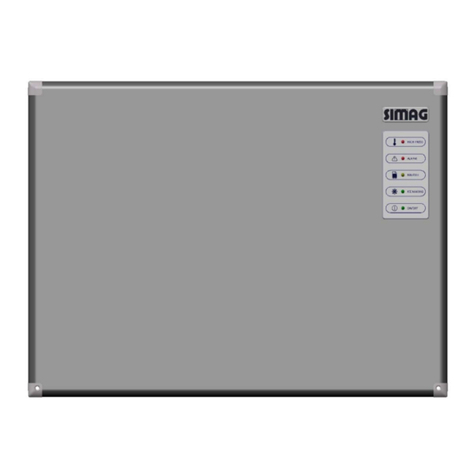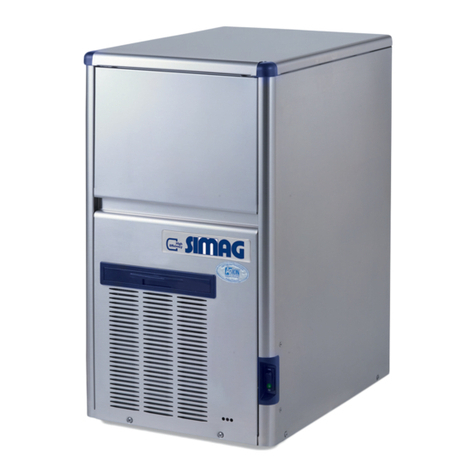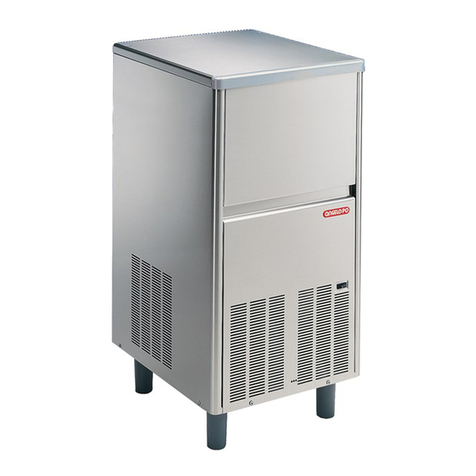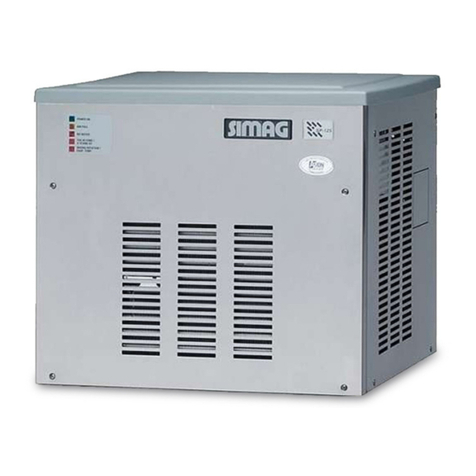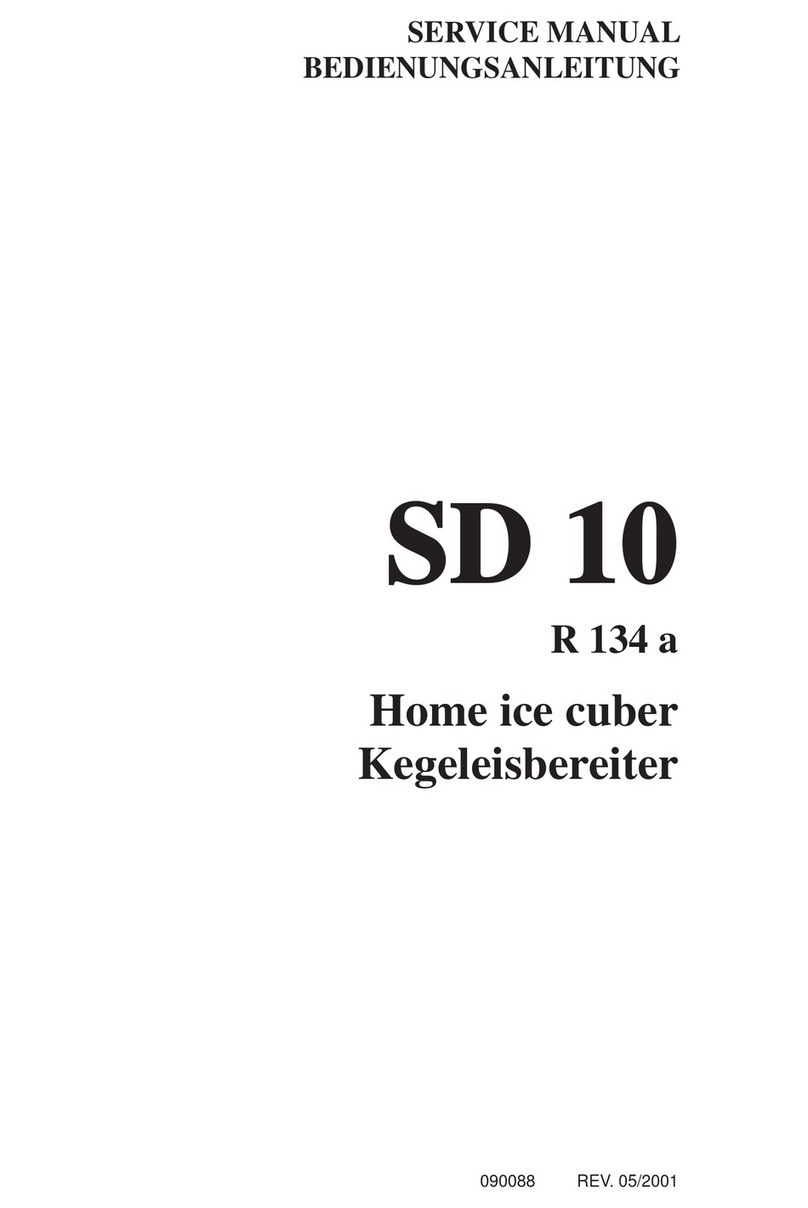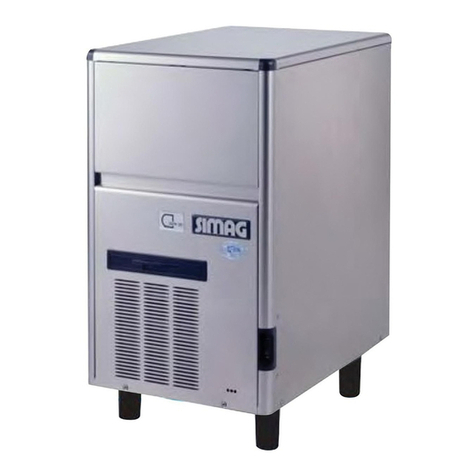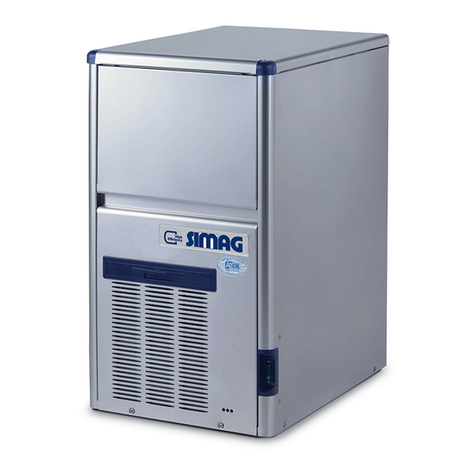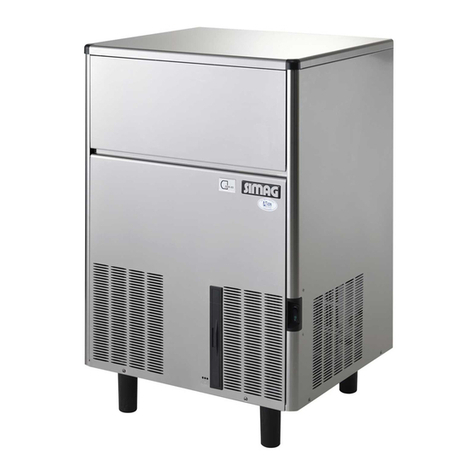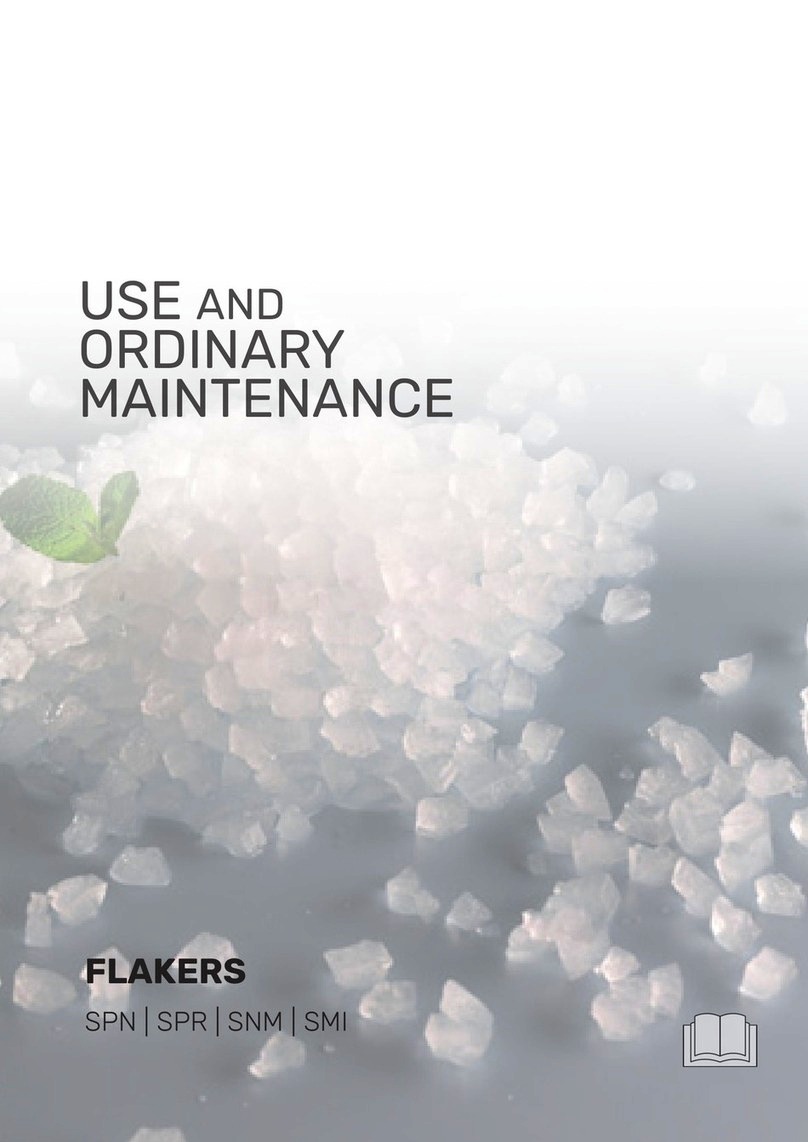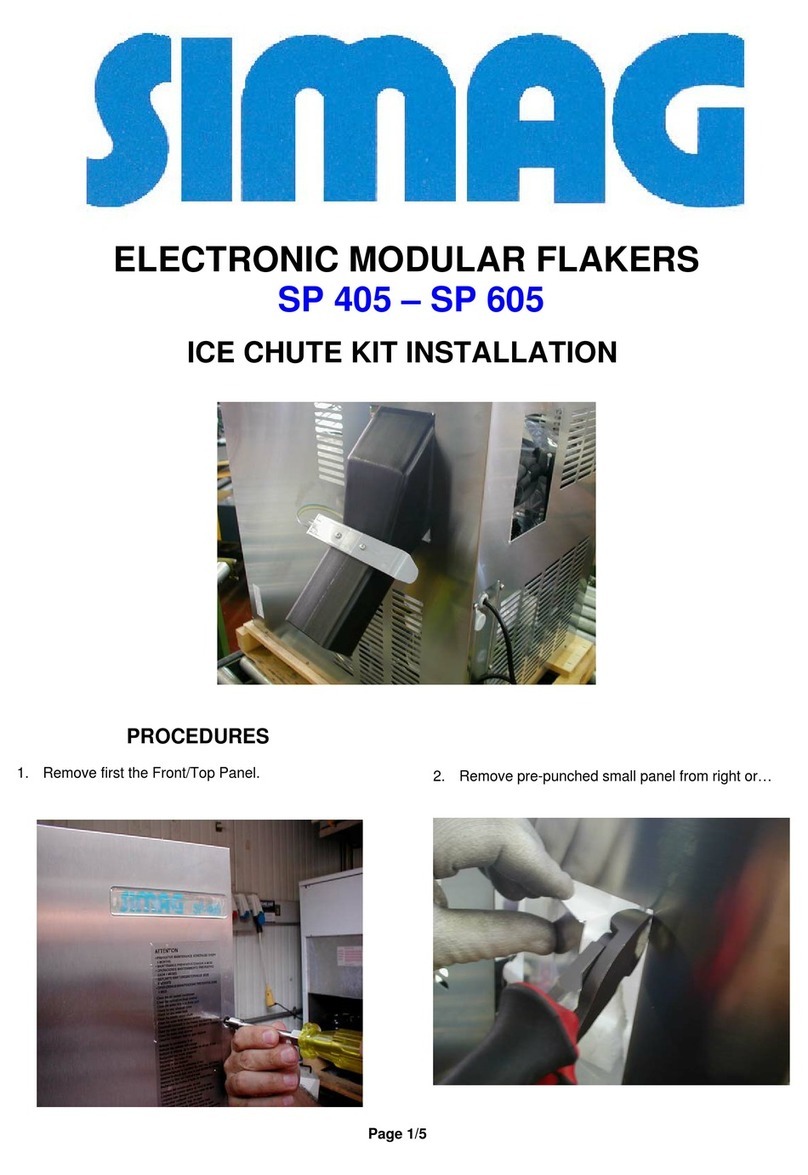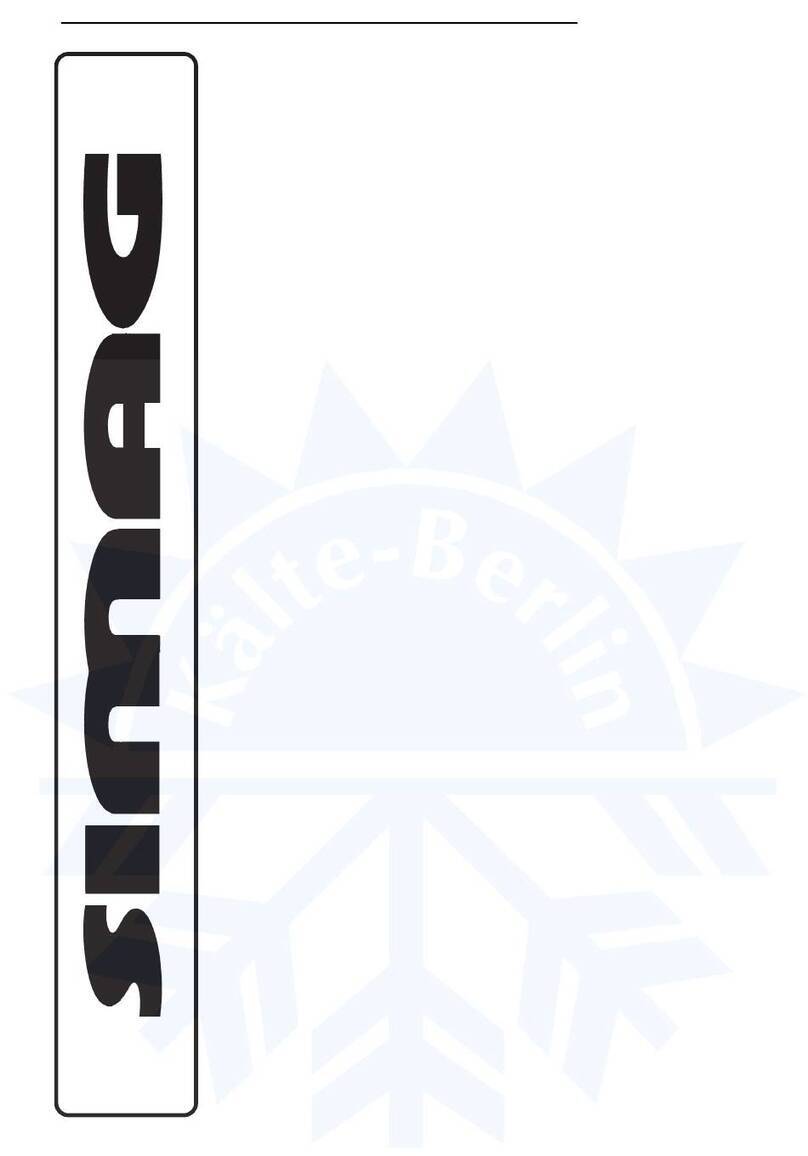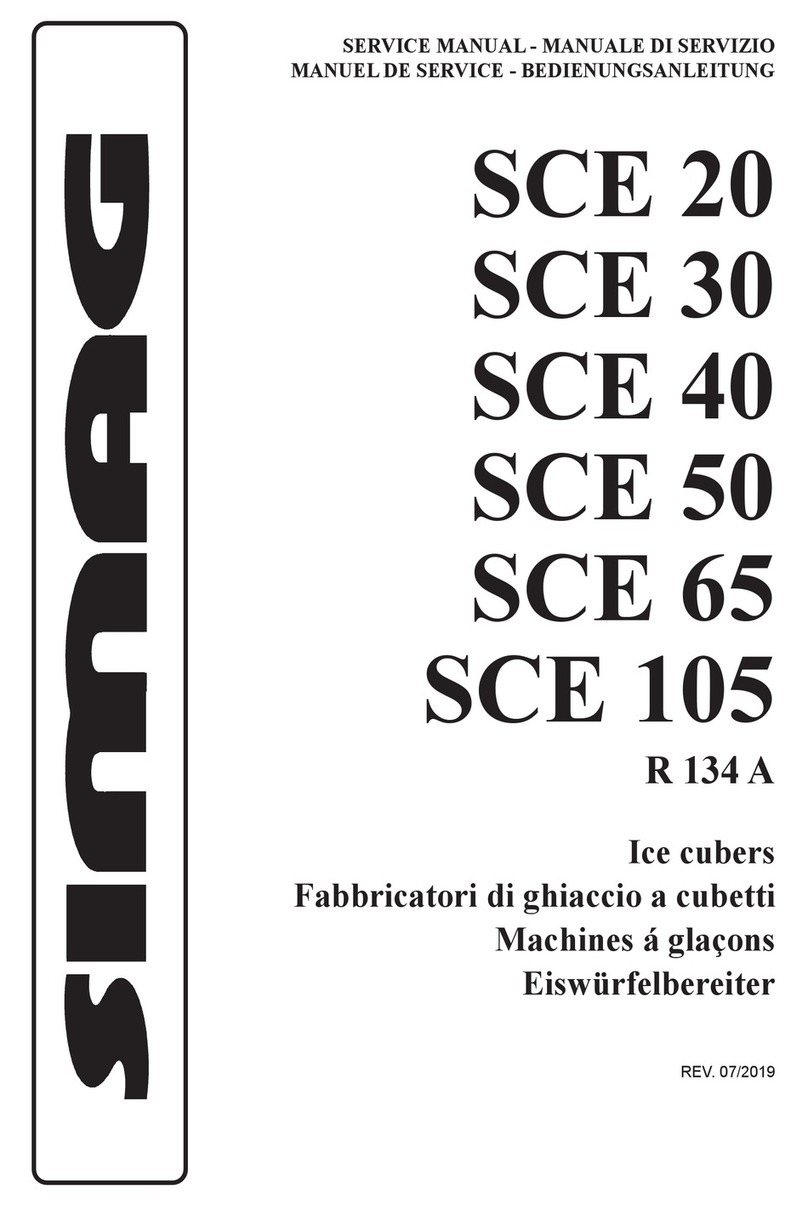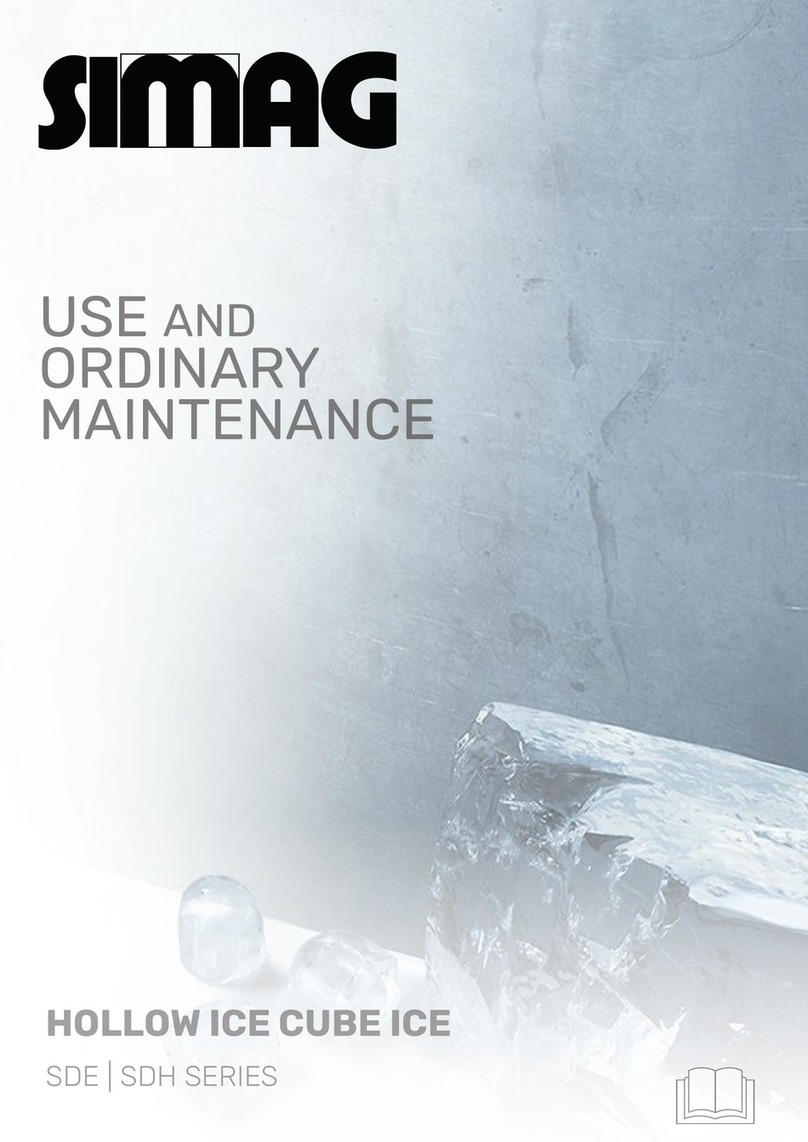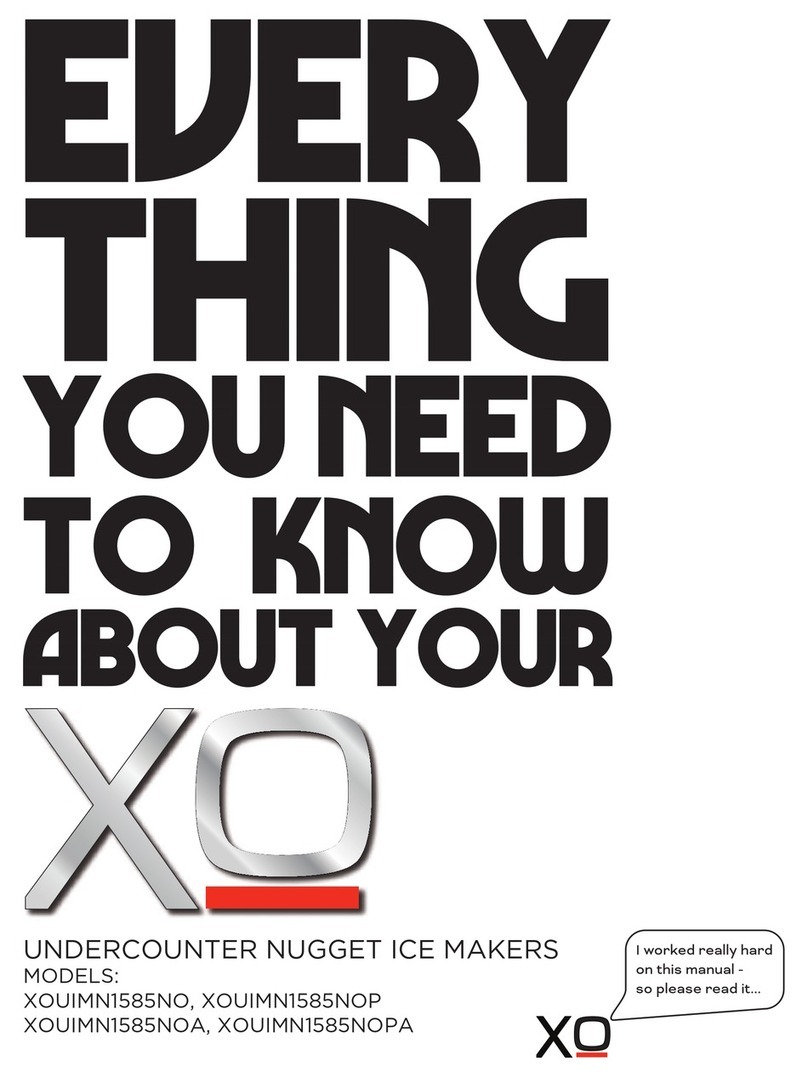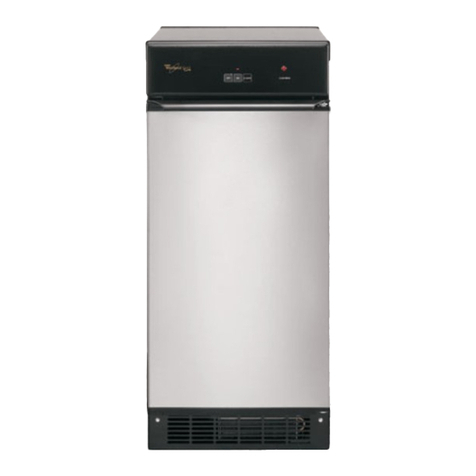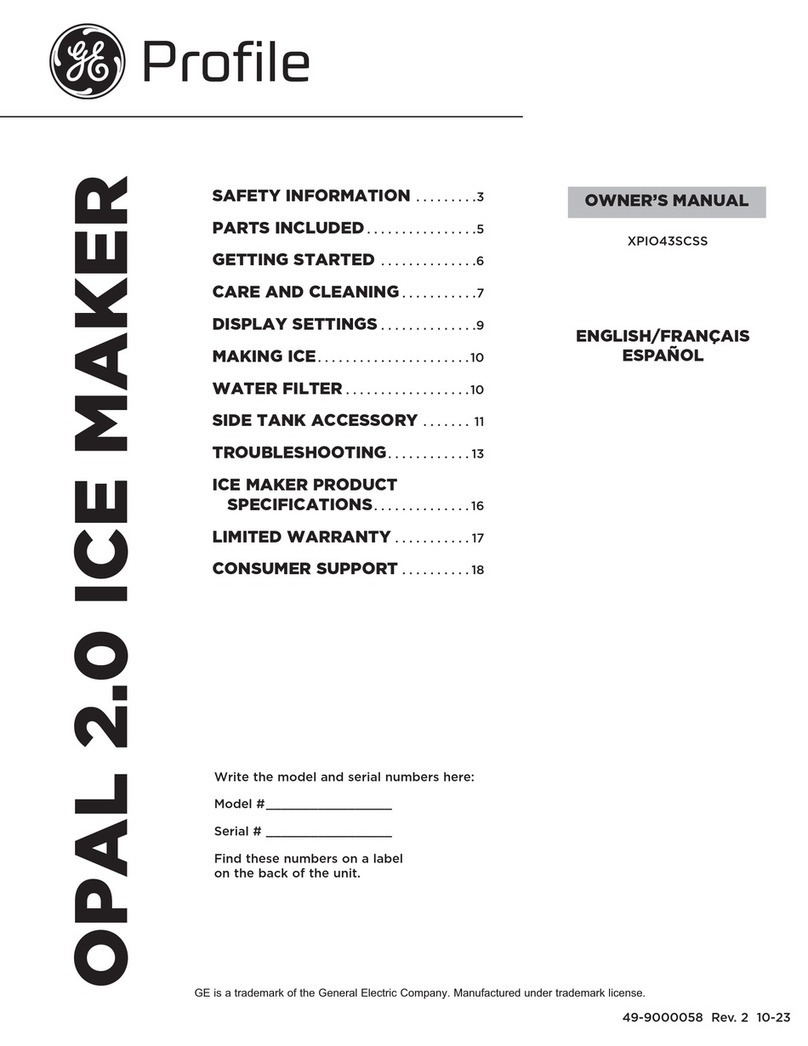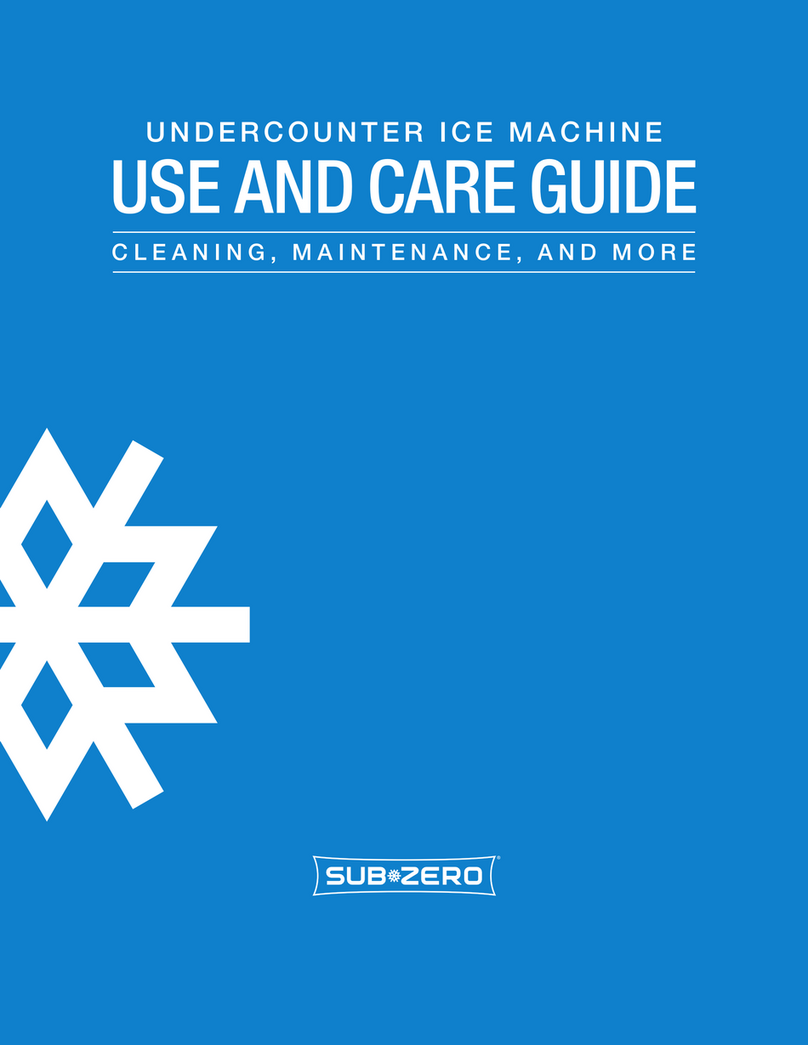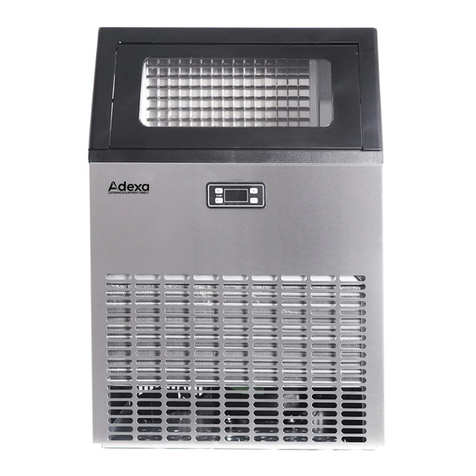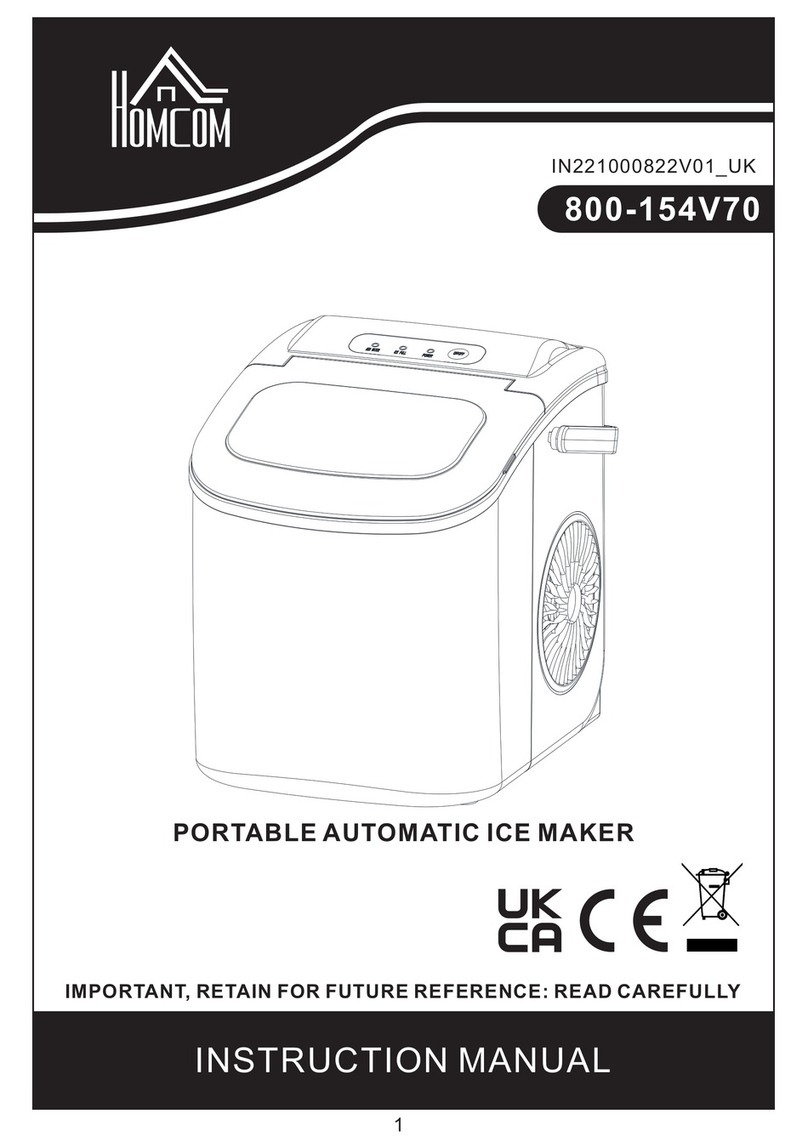SIMAG SDE34 User manual

SDE 30
SDE 34
SDE 40
SDE 50
SDE 64
SDE 84
SDE 170
SDE 220
Automatic cubers
090091.05 - REV. 11/2015

TABLE OF CONTENTS PAGE INHALTSVERZEICHNIS SEITE
GENERAL INFORMATION AND INSTALLATION 1 ALLGEMEINES UND INSTALLATION 14
Introduction 1 Einführung 14
Unpacking and inspection 1 Auspacken und Inspektion 14
Location and levelling 1 Maschinenplatz und lotgerechte Austellung 14
Electrical connection 1 Elektrische Anschlüße 15
Water supply and drain connection 2 Wasserversorgung und Abflußleitungen 15
Final check list 3 Schlußkontrollen 15
Installation practice 3 Installation 16
OPERATING INSTRUCTION 4 BETRIEBSANLEITUNG 17
Starp up 4 Inbetriebnahme 17
Operational checks 4 Ueberprüfung im Betrieb 17
OPERATING PRINCIPLES 6 FUNKTIONSSYSTEME 19
Freezing Cycle 6 Gefrierprozess 19
Harvest Cycle 6 Abtauprozess 19
Control sequence 7 Steuersequenzen 20
Electrical sequence 7 Sequenz Elektrische Bestandteile 20
Components description 8 Komponentenbeschrieb 21
Service diagnosis 10 Fonktionsfehler 23
MAINTENANCE AND CLEANING INSTRUCTIONS 12 WARTUNG UND REINIGUNGSANLEITUNG 25
General 12 Woraussetzung 25
Icemaker 12 Reinigung des Eisbereiters 25
Clean - Replace of air condenser filter 12 Reinigung - Austausch des Luftkondensatorfilters 25
Cleaning instructions of water system 12 Wartungs und Reinigungsanleitungen 26
A

B
38
37
36
35
34
33
32
31
30
29
28
27
26
25
24
23
22
21
20
19
18
47
46
45
44
43
42
41
40
39
38
37
36
35
34
33
32
31
30
29
28
27
26
25
24
23
Ice making capacity - Eisproduktionskapazität
SDE 30 SDE 34
SDE 40 SDE 50
AIR COOLED MODELS - LUFTKÜHLUNG
WATER TEMPERATURE - WASSERTEMPERATUR
AMBIENT TEMPERATURE - RAUMTEMPERATUR
ICE PRODUCED PER 24 HRS. - EISWÜRFEL PRODUKTION IN 24 STD.
30
29
28
27
26
25
24
23
22
21
20
19
18
17
16
15
14
Kg.
°C
10
21
32
38
27 21 1532 10
WATER COOLED MODELS - WASSERKÜHLUNG
WATER TEMPERATURE - WASSERTEMPERATUR
AMBIENT TEMPERATURE - RAUMTEMPERATUR
ICE PRODUCED PER 24 HRS. - EISWÜRFEL PRODUKTION IN 24 STD.
29
28
27
26
25
24
23
22
21
20
19
18
17
16
Kg. °C
10
21
32
38
27 21 1532 10
AIR COOLED MODELS - LUFTKÜHLUNG
AMBIENT TEMPERATURE - RAUMTEMPERATUR
ICE PRODUCED PER 24 HRS. - EISWÜRFEL PRODUKTION IN 24 STD.
Kg.
°C
10
21
32
38
27 21 1532 10
WATER COOLED MODELS - WASSERKÜHLUNG
WATER TEMPERATURE - WASSERTEMPERATUR
AMBIENT TEMPERATURE - RAUMTEMPERATUR
ICE PRODUCED PER 24 HRS. - EISWÜRFEL PRODUKTION IN 24 STD.
Kg. °C
10
21
32
38
27 21 1532 10
32
31
30
29
28
27
26
25
24
23
22
21
20
19
18
17
16
15
14
29
28
27
26
25
24
23
22
21
20
19
18
17
AMBIENT TEMPERATURE - RAUMTEMPERATUR
WATER COOLED MODELS - WASSERKÜHLUNG
WATER TEMPERATURE - WASSERTEMPERATUR
AMBIENT TEMPERATURE - RAUMTEMPERATUR
ICE PRODUCED PER 24 HRS. - EISWÜRFEL PRODUKTION IN 24 STD.
37
36
35
34
33
32
31
30
29
28
27
26
25
24
23
22
21
20
Kg. °C
10
21
32
38
27 21 1532 10
AMBIENT TEMPERATURE - RAUMTEMPERATUR
WATER COOLED MODELS - WASSERKÜHLUNG
WATER TEMPERATURE - WASSERTEMPERATUR
AMBIENT TEMPERATURE - RAUMTEMPERATUR
ICE PRODUCED PER 24 HRS. - EISWÜRFEL PRODUKTION IN 24 STD.
Kg. °C
10
21
32
38
27 21 1532 10
46
45
44
43
42
41
40
39
38
37
36
35
34
33
32
31
30
29
AIR COOLED MODELS - LUFTKÜHLUNG
ICE PRODUCED PER 24 HRS. - EISWÜRFEL PRODUKTION IN 24 STD.
Kg.
°C
10
21
32
38
27 21 1532 10
AIR COOLED MODELS - LUFTKÜHLUNG
ICE PRODUCED PER 24 HRS. - EISWÜRFEL PRODUKTION IN 24 STD.
Kg.
°C
10
21
32
38
27 21 1532 10
WATER TEMPERATURE - WASSERTEMPERATUR
SDE 64 SDE 84
WATER COOLED MODELS - WASSERKÜHLUNG
WATER TEMPERATURE - WASSERTEMPERATUR
AMBIENT TEMPERATURE - RAUMTEMPERATUR
ICE PRODUCED PER 24 HRS. - EISWÜRFEL PRODUKTION IN 24 STD.
61
60
59
58
57
56
55
54
53
52
51
50
49
48
47
Kg. °C
10
21
32
38
27 21 1532 10
WATER COOLED MODELS - WASSERKÜHLUNG
AMBIENT TEMPERATURE - RAUMTEMPERATUR
82
81
80
79
78
77
76
75
74
73
72
71
70
69
68
67
66
65
64
63
AMBIENT TEMPERATURE - RAUMTEMPERATUR
AIR COOLED MODELS - LUFTKÜHLUNG
ICE PRODUCED PER 24 HRS. - EISWÜRFEL PRODUKTION IN 24 STD.
Kg.
°C
10
21
32
38
27 21 1532 10
63
62
61
60
59
58
57
56
55
54
53
52
51
50
49
48
47
46
45
44
43
42
AMBIENT TEMPERATURE - RAUMTEMPERATUR
AIR COOLED MODELS - LUFTKÜHLUNG
ICE PRODUCED PER 24 HRS. - EISWÜRFEL PRODUKTION IN 24 STD.
Kg.
°C
10
21
32
38
27 21 1532 10
WATER TEMPERATURE - WASSERTEMPERATUR WATER TEMPERATURE - WASSERTEMPERATUR
91
90
89
88
87
86
85
84
83
82
81
80
79
78
77
76
75
74
73
72
71
70
ICE PRODUCED PER 24 HRS. - EISWÜRFEL PRODUKTION IN 24 STD.
Kg.
°C
10
21
32
38
27 21 1532 10
WATER TEMPERATURE - WASSERTEMPERATUR
WATER TEMPERATURE - WASSERTEMPERATUR
WATER TEMPERATURE - WASSERTEMPERATUR

B/bis
SD 215
215
213
211
209
207
205
203
201
199
197
195
193
191
189
187
185
183
181
179
177
175
173
171
169
167
165
163
161
ICE PRODUCED PER 24 HRS. - EISWÜRFEL PRODUKTION IN 24 STD.
AMBIENT TEMPERATURE - RAUMTEMPERATUR
172
170
168
166
164
162
160
158
156
154
152
150
148
146
144
142
140
138
136
134
132
130
128
126
124
122
120
118
116
114
112
110
108
106
104
102
100
98
96
94
92
90
Ice making capacity - Eisproduktionskapazität
SD 145
WATER COOLED MODELS - WASSERKÜHLUNG
WATER TEMPERATURE - WASSERTEMPERATUR
AMBIENT TEMPERATURE - RAUMTEMPERATUR
ICE PRODUCED PER 24 HRS. - EISWÜRFEL PRODUKTION IN 24 STD.
168
166
164
162
160
158
156
154
152
150
148
146
144
142
140
138
136
134
132
130
128
126
Kg. °C
10
21
32
38
27 21 1532 10
WATER COOLED MODELS - WASSERKÜHLUNG
AMBIENT TEMPERATURE - RAUMTEMPERATUR
AIR COOLED MODELS - LUFTKÜHLUNG
ICE PRODUCED PER 24 HRS. - EISWÜRFEL PRODUKTION IN 24 STD.
Kg. °C
10
21
32
38
27 21 1532 10
WATER TEMPERATURE - WASSERTEMPERATUR
215
213
211
209
207
205
203
201
199
197
195
193
191
189
187
185
183
181
179
177
175
173
171
169
167
165
163
161
159
157
155
153
151
149
147
145
143
141
139
137
135
133
131
129
127
125
123
121
119
117
115
113
111
AIR COOLED MODELS - LUFTKÜHLUNG
ICE PRODUCED PER 24 HRS. - EISWÜRFEL PRODUKTION IN 24 STD.
Kg. °C
10
21
32
38
27 21 1532 10
WATER TEMPERATURE - WASSERTEMPERATUR
AMBIENT TEMPERATURE - RAUMTEMPERATUR
Kg. °C
10
21
32
38
27 21 1532 10
WATER TEMPERATURE - WASSERTEMPERATUR

SDE 30

SDE 34

SDE 40

SDE 50

SDE 64

SDE 84

SDE 170

SDE 220

TECHNICAL SPECIFICATIONS - TECHNISCHE ANGABEN
OPERATING PRESSURES - BETRIEBSDRÜCKE
Discharge pressure - Hochdruckbereich
SDE 30 SDE 34 SDE 40 SDE 50 SDE 64 SDE 84 SDE 170 SDE 220
Air cooled (21°C)
Luftgekühlt (21°C) 8÷9 bar 8÷9 bar 8÷9,5 bar
8,5÷10 bar 8,5÷10 bar
8,5÷9,5 bar 15÷19,5 bar 16÷20 bar
Water cooled
Wassergekühlt 8,5÷10 bar 8,5÷10 bar 8,5÷10 bar 8,5÷10 bar 8,5÷10 bar 9,5 bar 17 bar 17 bar
Suction pressure - Niederdrück
Start / End of freezing cycle - Beginn / Ende der Gefrierfase
SDE 30 SDE 34 SDE 40 SDE 50 SDE 64 SDE 84 SDE 170 SDE 220
0,8÷0,1 bar 0,8÷0,1 bar 0,8÷0,1 bar 0,8÷0,1 bar 0,8÷0,1 bar 0,8÷0,1 bar 3,6÷1,5 bar 2,4÷1,3 bar
SDE30 SDE30W SDE34 SDE34W SDE40 SDE40W SDE50 SDE50W SDE64 SDE64W SDE84 SDE84W SDE170 SDE170W SDE220 SDE220W
Electric voltage 230/50/1 230/50/1 230/50/1 230/50/1 230/50/1 230/50/1 230/50/1 230/50/1
Normale Netzspannung -10 ÷+10% -10 ÷+10% -10 ÷+10% -10 ÷+10% -10 ÷+10% -10 ÷+10% -10 ÷+10% -10 ÷+10%
Condensation Air Water Air Water Air Water Air Water Air Water Air Water Air Water Air Water
Kühlung Luft Wasser Luft Wasser Luft Wasser Luft Wasser Luft Wasser Luft Wasser Luft Wasser Luft Wasser
Bin Capacity (kg)
Speiker Kapazität (kg) 6,5 10 12 17 20 30 50 68
Net weight (kg)
Netto Gewicht (kg) 28 40 40 45 48 63 94 131
Compressor power HP
Kompressorleistung PS 1/5 1/4 1/4 1/4 3/8 1/2 1 1.5
Running amps
Ampere 1.9 2.2 2.2 2.1 3.1 3.8 5.3 5.5
Start amps
Start Ampere 9.7 N.D. N.D. 12.5 17.8 20 29 32
Power (Watts)
Leistung (Watt) 380 220 360 245 350 430 380 580 470 620 500 1200 2000
Power cons. in 24 hrs (Kwh)
Stromverbrauch in 24 std (Kwh) 7 7.5 8.2 7.5 10.5 13 26 40
Wire size (mm
2
)
Kabelanzahl (mm
2
) 3 x 1 3 x 1 3 x 1 3 x 1 3 x 1 3 x 1 3 x 1,5 3 x 1,5
Refrig. charge R 134a (gr)
Kühlmittel Füll. R 134a (gr) 210 170 190 190 260 240 280 280 370 240 600 400 – – – –
Refrig. charge R 404a (gr)
Kühlmittel Füll. R 404a (gr) – – – – – – – – – – – – 630 500 660 500
R
efrigerant metering device
Capillary tube Capillary tube Capillary tube Capillary tube Capillary tube Capillary tube Capillary tube Capillary tube
Kältemittel-Expansionssystem
Kapillarrohr Kapillarrohr Kapillarrohr Kapillarrohr Kapillarrohr Kapillarrohr Kapillarrohr Kapillarrohr
E

WIRING DIAGRAM - SCHALTUNGSSCHEMA
230/50/1
AIR & WATER COOLED - LUFT UND WASSERGEKÜHLT
SDE 30-34-40-50-64-84

WIRING DIAGRAM - SCHALTUNGSSCHEMA
230/50/1
AIR & WATER COOLED - LUFT UND WASSERGEKÜHLT
SDE170 – SDE220

GENERAL INFORMATION
AND INSTALLATION
A. INTRODUCTION
This manual provides the specifications and the
step-by-step procedures for the installation, start-
up and operation, maintenance and cleaning for
the SIMAG SDE Series Icemakers.
The SIMAG SDE cubers are quality designed,
engineered and manufactured.
Their ice making systems are thoroughly tested
providing the utmost in flexibility to fit the needs
of a particular user.
NOTE. To retain the safety and performance
built into this icemaker, it is important that
installation and maintenance be conducted
in the manner outlined in this manual.
B. UNPACKING AND INSPECTION
1. Call your authorized SIMAG Distributor or
Dealer for proper installation.
2. Visually inspect the exterior of the packing
and skid. Any severe damage noted should be
reported to the delivering carrier and a concealed
damage claim form filled in subjet to inspection of
the contents with the carrier’s representative
present.
3. a) Cut and remove the plastic strip securing
the carton box to the skid.
b) Remove the packing nails securing the
carton box to the skid.
c) Cut open the top of the carton and remove
the polystyre protection sheet.
d) Pull out the polystyre posts from the
corners and then remove the carton.
4. Remove the front and the rear panels of the
unit and inspect for any concealed damage.
Notify carrier of your claim for the concealed
damage as stated in step 2 above.
5. Remove all internal support packing and
masking tape.
6. Check that refrigerant lines do not rub
against or touch other lines or surfaces, and that
the fan blades move freely.
7. Check that the compressor fits snugly onto
all its mounting pads.
8. See data plate on the rear side of the unit
and check that local main voltage corresponds
with the voltage specified on it.
CAUTION. Incorrect voltage supplied to
the icemaker will void your parts
replacement program.
9. Remove the manufacturer’s registration
card from the inside of the User Manual and fill-
in all parts including: Model and Serial Number
taken from the data plate.
Forward the completed self-addressed
registration card to SIMAG factory.
C. LOCATION AND LEVELLING
WARNING. This Ice Maker is designed for
indoor installation only. Extended periods
of operation at temperature exceeding
the following limitations will constitute
misuse under the terms of the SIMAG
Manufacturer’s Limited Warranty resulting
in LOSS of warranty coverage.
1. Position the machine bin in the selected
permanent location and tighten the four legs
(SDE 30- 34 - 40 - 50 - 64 - 84 - 170 - 220).
Criteria for selection of location include:
a) Minimum room temperature 10 °C (50°F)
and maximum room temperature 40°C (100°F).
b) Water inlet temperatures: minimum 5°C
(40°F) and maximum 40°C (100°F).
c) Well ventilated location for air cooled
models (clean the air cooled condenser at
frequent intervals).
d) Service access: adequate space must be
left for all service connections through the rear of
the ice maker. A minimum clearance of 15 cm
(6") must be left at the sides of the unit for routing
cooling air drawn into and exhausted out of the
compartment to maintain proper condensing
operation of air cooled models.
NOTE. With the unit in “built-in” conditions,
the ice production is gradually reduced in
respect to the levels shown in the graph, up
to a maximum of 10% at room temperatures
higher than 32
°
C.
The daily ice-making capacity is directly
related to the condenser air inlet temperatu-
re, water temperature and age of the machine.
To keep your SIMAG CUBER at peak perfor-
mance levels, periodic maintenance checks
must be carried out as indicated on this
manual.
2. Level the Icemaker in both the left to right
and front to rear directions by means of the
adjustable legs.
D. ELECTRICAL CONNECTIONS
See data plate for current requirements to
determine wire size to be used for electrical
connections. All SIMAG icemakers require a
solid earth wire.
All SIMAG ice machines are supplied from the
factory completely pre-wired and require only
electrical power connections to the wire cord
provided at the rear of the unit.
Page 1

Make sure that the ice machine is connected to
its own circuit and individually fused (see data
plate for fuse size).
The maximum allowable voltage variation should
not exceed -10% and +10% of the data plate
rating. Low voltage can cause faulty functioning
and may be responsible for serious damage to
the overload switch and motor windings.
NOTE. All external wiring should conform to
national, state and local standards and
regulations.
Check voltage on the line and the ice maker’s
data plate before connecting the unit.
E. WATER SUPPLY AND DRAIN
CONNECTIONS
GENERAL
When choosing the water supply for the cuber
consideration should be given to:
a) Length of run
b) Water clarity and purity
c) Adequate water supply pressure
Since water is the most important single ingredient
in producing ice you cannot emphasize too much
the three items listed above.
Low water pressure, below 1 bar may cause
malfunction of the ice maker unit.
Water containing excessive minerals will tend to
produce cloudy colored ice cubes, plus scale
build-up on the interior parts of the water system.
WATER SUPPLY
Connect the 3/4" GAS male of the water inlet
fitting, using the food grade flexible tubing supplied
with the machine, to the cold water supply line
with regular plumbing fitting and a shut-off valve
installed in an accessible position between the
water supply line and the unit.
If water contains a high level of impurities, it is
advisable to consider the installation of an
appropriate water filter or conditioner.
WATER SUPPLY - WATER COOLED MODELS
(SDE 84-170-220)
The water cooled versions of SIMAG Ice Makers
require two separate inlet water supplies, one for
the water making the ice and the other for the
water cooled condenser.
Connect the 3/4" GAS male fitting of the water
inlet, using the flexible tubing supplied with the
unit, to the cold water supply line with regular
plumbing fitting and a shut-off valve installed in
an accessible position between the water supply
line and the unit.
WATER DRAIN
Connect the drain fitting with a plastic tube to an
open trapped and vented drain. When the drain
is a long run, allow 3 cm pitch per meter (1/4"
pitch per foot).
On water cooled versions, the water drain line
from the condenser is internally connected with
the drain fitting of the unit.
It is strongly recommended therefore to install a
vertical open vent on unit drain line high point to
ensure good draining and to direct the drain line
to a trapped and vented floor drain receptacle.
NOTE. The water supply and the water drain
must be installed to conform with the local
code. In some case a licensed plumber and/
or a plumbing permit is required.
Page 2

G. INSTALLATION PRACTICE
1. Hand shut-off valve
2. Water filter
3. Water supply line (flexible hose)
4. 3/4" GAS male fitting
5. Vented drain
6. Open trapped vented drain
7. Drain fitting
8. Main switch
9. Power line
7. Have the bolts holding the compressor down
been checked to ensure that the compressor is
snugly fitted onto the mounting pads?
8. Check all refrigerant lines and conduit lines
to guard against vibrations and possible failure.
9. Have the bin liner and cabinet been wiped
clean?
10. Has the owner/user been given the User
Manual and been instructed on the importance of
periodic maintenance checks?
11. Has the Manufacturer’s registration card been
filled in properly? Check for correct model and
serial number against the serial plate and mail
the registration card to the factory.
12. Has the owner been given the name and the
phone number of the authorized SIMAG Service
Agency serving him?
F. FINAL CHECK LIST
1. Is the unit in a room where ambient
temperatures are within a minimum of 10 °C
(50°F) even in winter months?
2. Is there at least a 15 cm (6") clearance
around the unit for proper air circulation?
3. Is the unit level? (IMPORTANT)
4. Have all the electrical and plumbing
connections been made, and is the water supply
shut-off valve open?
5. Has the voltage been tested and checked
against the data plate rating?
6.
Has the water supply pressure been checked
to ensure a water pressure of at least 1 bar
(14 psi)? Open the shut-off valve and verify the
absence of water losses from the connections.
WARNING. This icemaker is not designed for outdoor installation and will not function in
ambient temperatures below 10°C (50°F) or above 40°C (100°F).
This icemaker will malfunction with water temperatures below 5 °C (40°F) or above 40 °C
(100°F).
Page 3

OPERATING
INSTRUCTIONS
START UP
After having correctly installed the ice maker and
completed the plumbing and electrical
connections, perform the following “Start-up”
procedure.
A. Put the icemaker in operation by moving the
unit master switch, located on the cabinet front,
to the ON position.
NOTE. The icemaker control is factory set
with the timer in defrost/harvest cycle.
T
w
The unit starts operating in the “defrost cycle”
with the following components being activated:
THE WATER INLET SOLENOID VALVE
THE HOT GAS SOLENOID VALVE
THE CONTACTOR COIL (SDE84-170-220)
THE FAN MOTOR (only SDE30÷50) air cooled
THE COMPRESSOR
THE TIMER
B. During the water filling operation, check to
see that the incoming water dribblers, through
the evaporator platen dribbler holes, down into
the sump reservoir to fill it up and also that the
incoming surplus of water flows out through the
overflow pipe into the drain line.
NOTE. If, in the defrost cycle length, the
machine sump reservoir does not get filled
with water up to the rim of the overflow pipe,
remove the front panel and rotate the shaft of
the timer so to cause the dropping of the two
microswitches actuators into the beginning
of the cam slot and check for:
1. The water pressure of the water supply
line, it must be at least 1 bar (14 psig)
Minimum (Max 5 bar-70 psig).
2. The filtering device installed in the water
line that may reduce the water pressure
below the Minimum value of 1 bar (14 psig).
3. Any clogging situation in the water circuit
like the inlet water strainer and/or the flow
control.
OPERATIONAL CHECKS
C. At completion of the water filling phase the
unit initiate automatically the first freezing cycle
with the start up of (Fig.1):
COMPRESSOR
CONTACTOR COIL (SDN85-145-215)
WATER PUMP
FAN MOTOR (in air cooled version)
D. Check to see through the ice discharge
opening that the spray system is correctly seated
and that the water jets uniformely reach the
interior of the inverted mold cups or the exterior
of the evaporator tips; also make sure that the
plastic curtain is hanging freely and there is not
excessive water spilling through it.
E. The ice making process takes place thereby,
with the water sprayed into the molds or onto the
tips that gets gradually refrigerated by the heat
exchange with the refrigerant flowing into the
evaporator serpentine.
During the first portion of the freezing cycle, the
timer assy is standing.
.
.
F. Then, as the cube size control cut-in point is
reached by the evaporator temperature the control
of the cycle is passed to the timer.
The components in operation during this 2nd
phase of the cycle are (Fig.2):
COMPRESSOR
CONTACTOR COIL (SDN85-145-215)
WATER PUMP
FAN MOTOR (in air cooled version)
TIMER
G. After about 18 ÷20 minutes from the
beginning of the freezing cycle, in an hypothetic
ambient temperature of 21°C, the defrost cycle
takes place with the hot gas and the water inlet
valves being simoultaneously activated.
The electrical components in operation are (Fig.3):
COMPRESSOR
CONTACTOR COIL (SDN85-145-215)
WATER INLET SOLENOID VALVE
HOT GAS VALVE
TIMER
FAN MOTOR (only SDE 30÷50) air cooled
H. Check, during the defrost cycle, that the
incoming water flows correctly into the sump
reservoir in order to refill it and that the surplus
overflows through the overflow drain tube.
I. Check the texture of ice cubes just released.
They have to be of the right size with a thickness
of about 7÷8 mm.
If the ice cubes have not the correct size, wait for
a second harvest before attempting any
adjustment by setting the cube size control.
Page 4

Page 5
By rotating the control setting screw clockwise
the ice cube thickness can be increased; on the
contrary the thickness can be reduced by turning
the setting screw counterclockwise.
If the ice cubes are shallow and cloudy, it is
possible that the ice maker runs short of water
during the freezing cycle second phase or, the
quality of the supplied water requires the use of
an appropriate water filter or conditioner.
J. With the icemaker in the harvest cycle, hold
ice against the bin thermostat control bulb to
test its shut off. This should cause the ice
maker to shut OFF after 30 seconds, 1 minute
at the most, namely when the control bulb
temperature drops to reach +1°C.
NOTE. In case this test is performed during
the freezing cycle, the unit will shut OFF
only at the end of the freezing cycle.
Within minutes after the ice is removed
from the sensing bulb, the bulb will warm
up to reach + 4°C and consequently will
cause the icemaker to restart from the
harvest (defrost) cycle.
K. Instruct the owner/user on the general
operation of the ice machine and about
the cleaning and care it requires.
This manual suits for next models
16
Table of contents
Other SIMAG Ice Maker manuals
Popular Ice Maker manuals by other brands
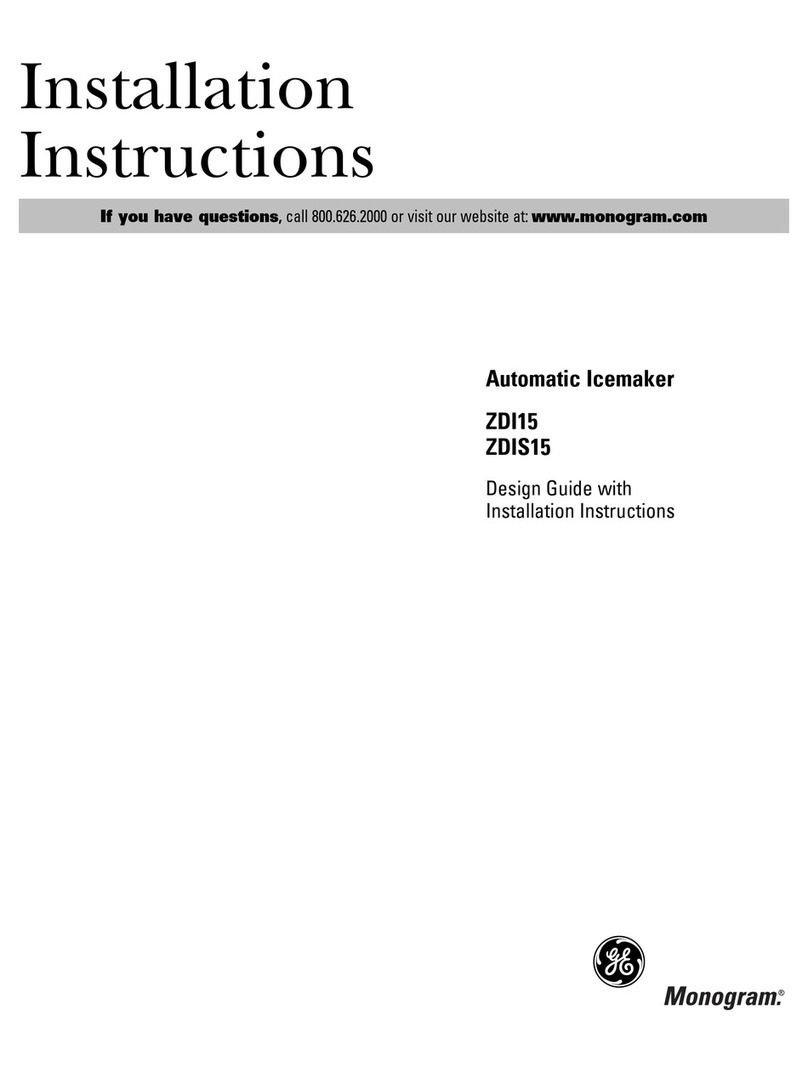
Monogram
Monogram ZDI15 installation instructions

Aquila
Aquila Pelletizer PE50 Original instruction manual
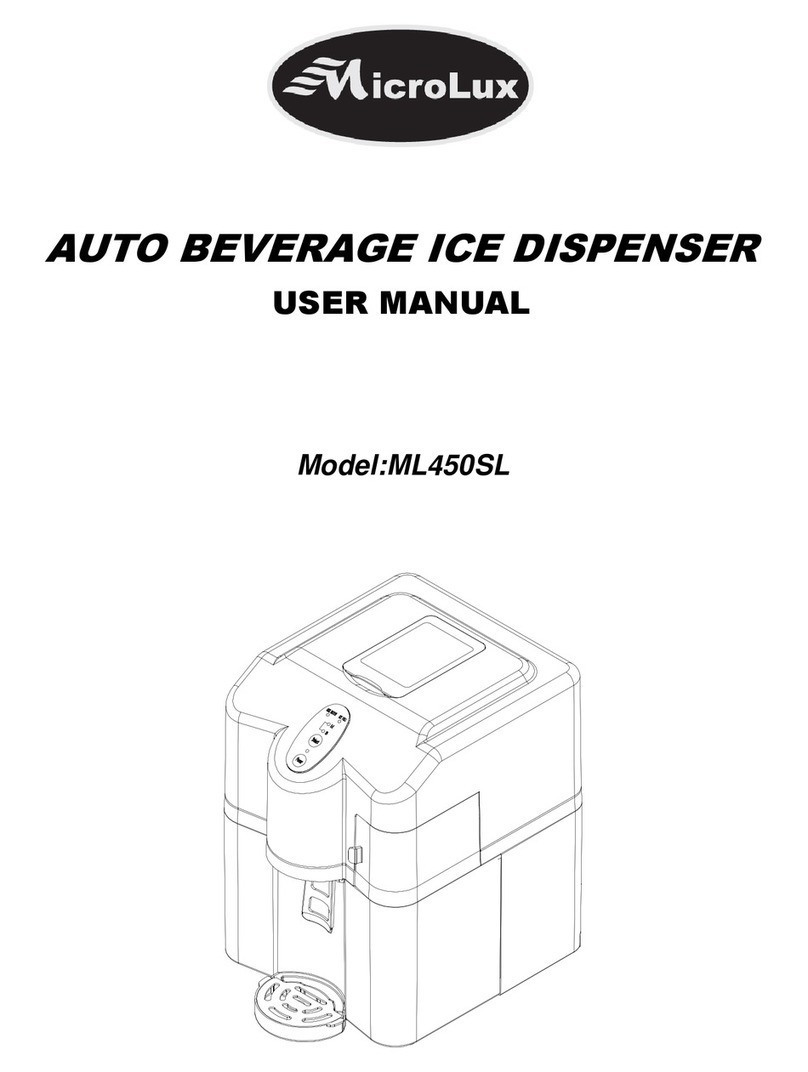
MicroLux
MicroLux ML450SL user manual
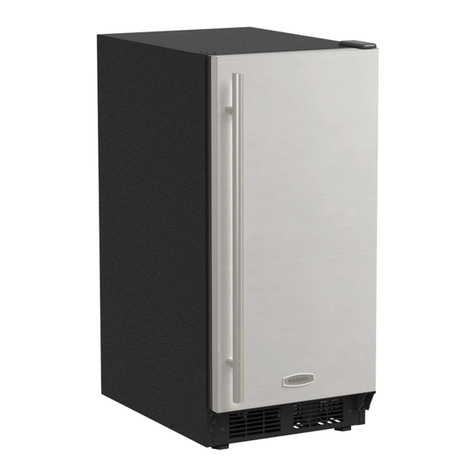
Marvel
Marvel MA15CRS1XS Installation, operation and maintenance instructions
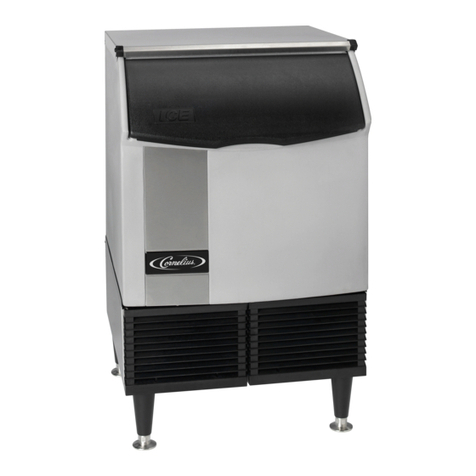
Cornelius
Cornelius CCM0330 Service and maintenance manual
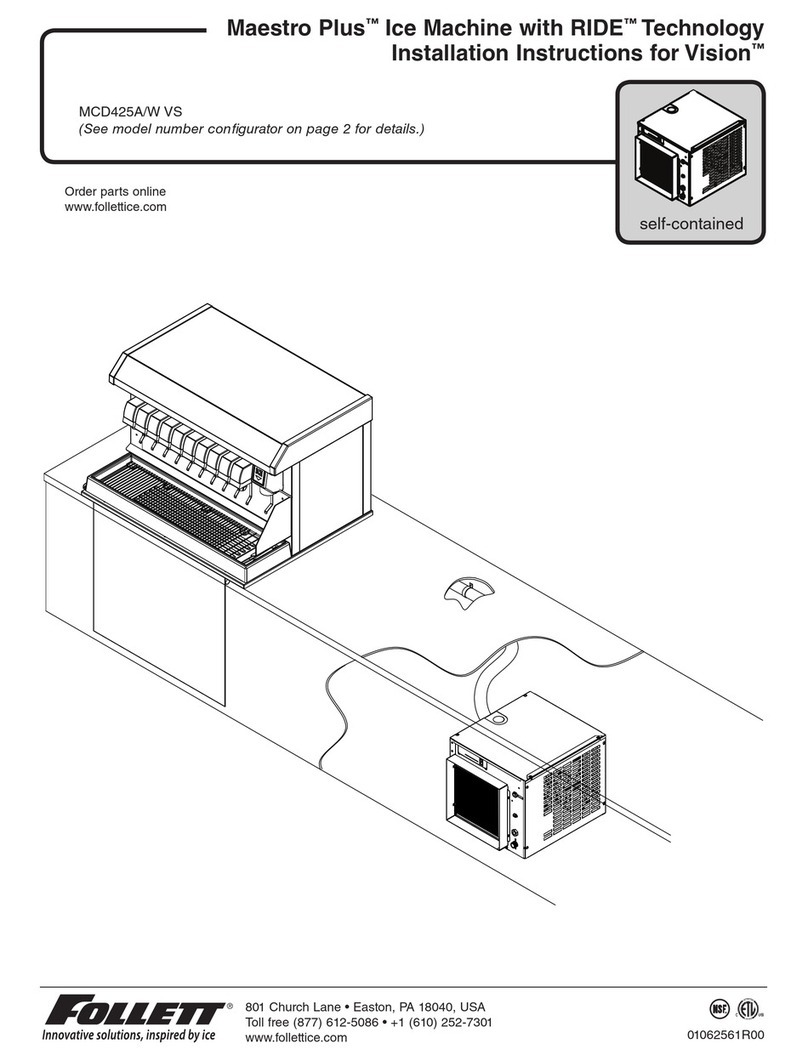
Follett
Follett Maestro Plus MCD425WBS installation instructions
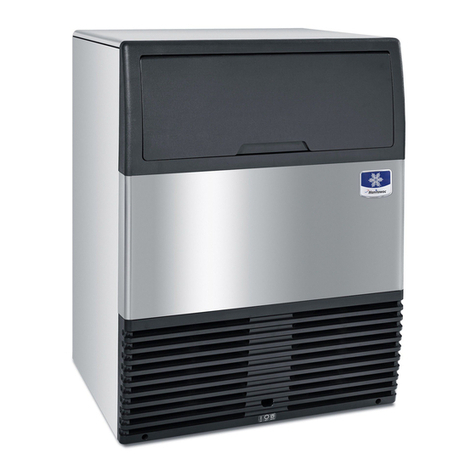
Manitowoc
Manitowoc UG Series Technician's handbook
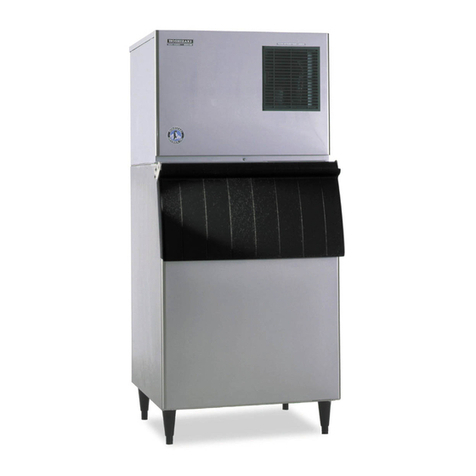
Hoshizaki
Hoshizaki KML-250MAH Cleaning & Sanitizing
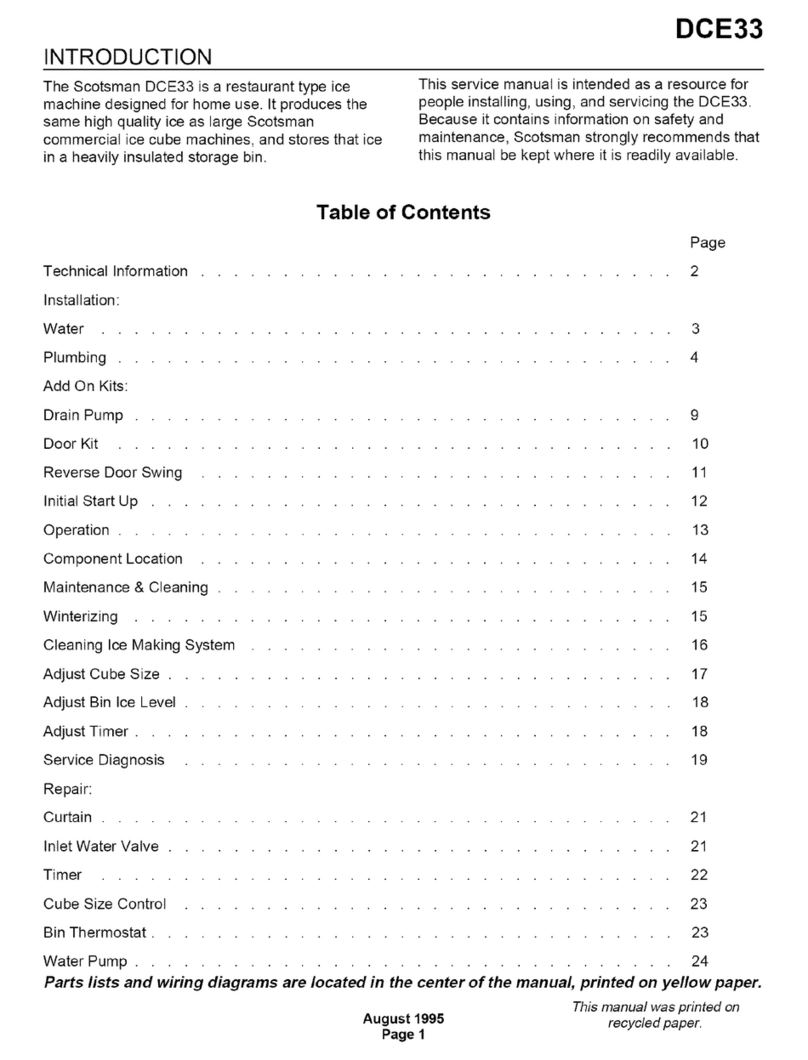
Scotsman
Scotsman DCE33 Series user manual

Metos
Metos Muster 350 User's installation and operation manual

Orien
Orien FS260IM user manual
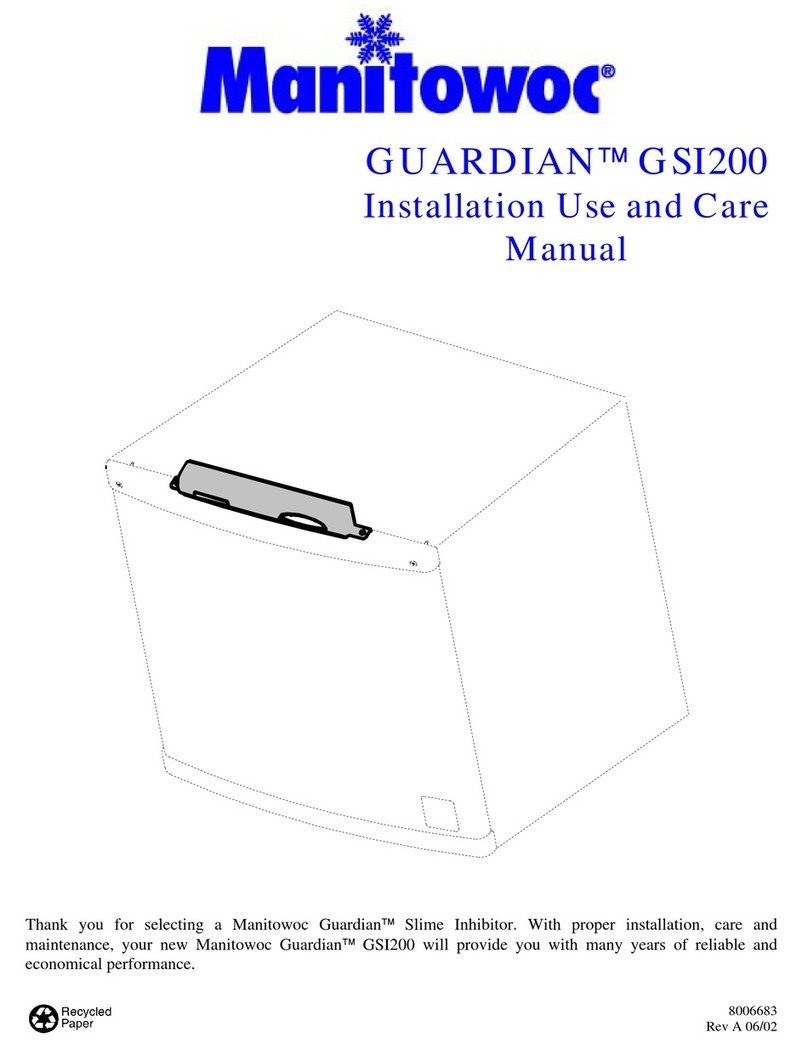
Manitowoc
Manitowoc GUARDIAN GSI200 Installation use and care manual
